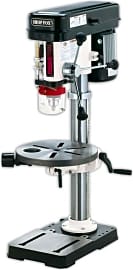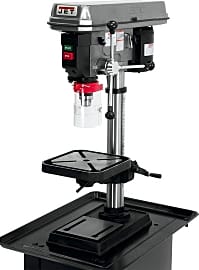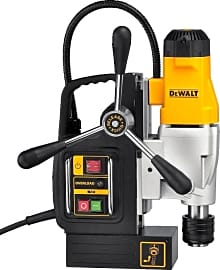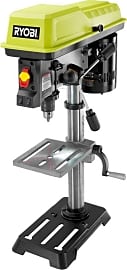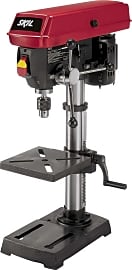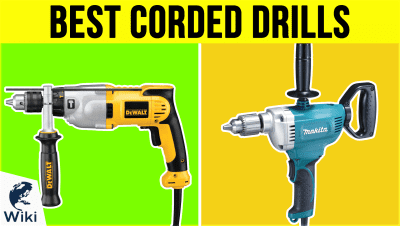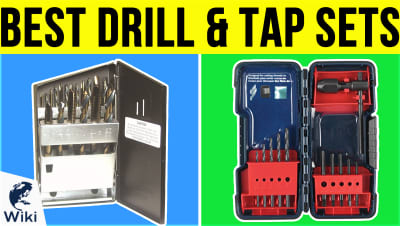The 10 Best Drill Presses

This wiki has been updated 41 times since it was first published in March of 2015. Whether you are an avid amateur DIYer or a professional, no workshop is complete without a drill press. They offer accuracy, power, and safety, and let you bore vertical holes using variable speeds at predetermined depths. There is no better way to repeat drilling procedures efficiently and precisely. Our picks include a wide range of dependable models suitable for most needs. When users buy our independently chosen editorial picks, we may earn commissions to help fund the Wiki.
Editor's Notes
November 06, 2020:
Often referred to as a drill machine or a pillar drill, a drill press is designed to ensure holes are aligned precisely, and at exact depths, in a variety of materials like wood, metal, and in some cases even glass. They utilize a solid worktable, to which materials can be clamped, and a variable speed drill head that moves up and down by means of a mechanical feed handle. They provide greater precision than a handheld drill, are much more powerful, and can be used with a variety of drill bits for boring, reaming, countersinking, counterboring, and tapping.
Choosing a suitable drill press will depend on your needs, the materials you work with, and how frequently you need to use it. In this most recent update, we have added several new models, suitable for occasional home use and small workshops, to powerful commercial-grade units for daily use. As a budget option, we previously recommended the Rikon 30-100, however, due to issues with accuracy and belt slippage, we replaced it with the Ryobi DP103L, which features a hard-wearing induction motor and uses a laser alignment system similar to that found on the Skil 3320-01 and the Wen 4214. The latter also features a digital speed readout allowing you to target the exact RPM for your project with the simple turn of a knob. We replaced the Grizzly G7943 with the slightly newer Grizzly Industrial G9969. This unit has a 1 horsepower motor, as opposed to the 3/4 horsepower of the previous model, and features a unique swivel post that allows the drill head to be positioned at almost any angle, making it a versatile option for those who need to work with bulky materials or awkward drilling angles. The Grizzly is a benchtop drill but boasts similar power to some of the floor-standing models such as the Shop Fox W1668 or the Jet JDP-20MF.
The Powermatic PM2800B was the most powerful drill in the ranking, and the most expensive, yet several reports of accuracy and quality issues made us believe that it's not worth this high price tag, therefore we have replaced it with the Nova 58000 Voyager. For a similar outlay, you get a state-of-the-art machine that uses smart technology to automate the speed, power, and depth, while its built-in sensors continually monitor and adjust the settings and can detect problems, giving it superior safety and functionality.
November 21, 2019:
Removed the Craftsman 10-inch because of availability concerns and the Wen 4208 because better models became available. Added the Shop Fox W1668 and the Powermatic PM2800B.
Woodworkers will be particularly drawn to the Shop Fox because of its spindle sander attachment. The drive mechanism itself has an oscillating function that makes sanding easier and it leaves less patterned abrasions on the material.
Using some types of drill bits on a drill press can be dangerous. Care should be taken to make sure the bits being used are approved to be used with a drill press. Working with wood creates fine particles that can be hazardous if inhaled for long periods of time. Always use breathing protection to avoid health complications.
Special Honors
Baileigh DP-1850G This drill press uses gears to drive the spindle, which can transfer much more torque to the bit than the belt drive that most consumer models use. It is particularly effective at making the most use of the substantial power produced by the 2 horsepower, 3-phase induction motor. baileigh.com
Precision, Convenience, And Power
The table is directly mounted to the column and is used to support the object into which the press will be boring.
Whether you're a veteran woodworker, part of a construction crew, or you just love to have the most versatile tools in your workshop at home, then you'll need a reliable drill press to handle those tough jobs that couldn't be accomplished without extra leverage and power.
Also known as a pedestal drill, the drill press is a large machine with a primary purpose of boring into and enlarging precise holes in different materials, including woods and metal. Although handheld drills are compact in design and effective when it comes to working in tight spaces, they don't offer the same kind of precision or cutting accuracy that a drill press can deliver.
Today, many drill presses are powered by an electric motor with varying degrees of available horsepower, depending on application and need. The greater the horsepower, the easier and faster the drilling process becomes, which comes in quite handy when needing to drill multiple holes into an object as a contractor.
The two basic types of drill presses include bench and floor-style models. The bench drill press is small in size, low in cost, it attaches to the top of an ordinary working surface (e.g. a garage workbench), and is designed for handling small hobbyist cutting jobs. The bench model is less powerful than its floor counterpart. By contrast, the floor drill press offers standalone operation for heavy-duty jobs using large materials. Floor models are often equipped with horsepower that is several times greater than that of the bench models along with built-in variable speed controls.
Regardless of the press being used, several components are involved. The drill head is located near the top of the device and it houses both the unit's motor and variable speed control mechanism. This mechanism is further used to control the spindle, which is the part of the device that actually rotates as you bore into various objects. The spindle is further housed and mounted inside the quill, which essentially acts as the sleeve of the drill press with an ability to be moved up or down by either manual or automatic feeding.
Of equal importance are the drill press table, column, and base (for floor models). The table is directly mounted to the column and is used to support the object into which the press will be boring. The table also moves up and down the length of the column, while both the machine's head and base are clamped to it at either end. The base is typically made from cast iron for increased stability as well as to accommodate heavy drilling jobs.
Knowing The Drill
Drill presses offer several advantages over their handheld counterparts, especially as the nature of a cutting job gets larger and more complex. For that reason, there are certain key aspects one must consider before investing in the device for their workshop. Firstly is the device's degree of accuracy. Unlike a hand drill that requires holding and angling manually, perfectly-aligned, evenly-spaced holes with precise depths, widths and angles can be drilled with the machine, removing one's hit-or-miss factor from its operation. This becomes quite important in the professional sense when metals or woods require drilling to exact specifications.
There is also more control leveraged by the machine, minimizing any potential hand fatigue that would further compromise one's level of accuracy.
If you're a woodworker, for example, you can use the machine to quickly drill into a piece of hardwood, while its spindle is set to a specific angle relative to the wood itself. There is also more control leveraged by the machine, minimizing any potential hand fatigue that would further compromise one's level of accuracy. For that reason, it's important to ensure the reliability of both the spindle and equipment.
Secondly is variable speed control. Drill presses are capable of boring identical holes at the same exact speed or at multiple speeds to accommodate different material thicknesses. This not only increases accuracy, but it makes one's work go faster. For that reason, it's important to find a drill press with as many available custom speed settings as possible to handle most any material you might need.
Looking for a unit with plenty of power is also important, as it will save you energy, time, and effort. The more powerful your machine's motor is, the easier it becomes to support large drill bits for creating wide holes.
Many drill presses also feature tables capable of tilting and rotating, which can come in handy when working with materials that are not uniform in shape or that require drilling in particular places that aren't as easy for the spindle and drill bit to access vertically.
Finally, one must consider their safety when operating such a piece of machinery. Variable speed control can help to prevent injuries from excessive force, while providing a superior command over the drill bit. Additionally, using a clamp or vice to fasten objects to the machine's working table will prevent slippage and mistakes.
A Brief History Of The Drill Press
The pedestal drill is considered one of the oldest forms of machine tools, dating as far back as the latter part of the seventeenth century. The earliest form of the drill press evolved from rudimentary hand tools used to manually bore into objects, including the u-shaped brace and bit. Up until the beginning of the nineteenth century, the human-operated drill press was one of the most important tools available to professional craftsmen and mechanics due to its versatility and hand-crank functionality.
By the 1930s, the device became more widely available to home workshop users.
The precision of a stationary drill press was advantageous to factory workers and blacksmiths, as it allowed them to make repetitive cuts with improved accuracy. Even without electric power, these wall-mounted drill presses were much faster and more accurate than hand-operated electric drills. These early machines also made use of a feed arm and wheel to drive their spinning drill bits through wood and other objects. Removing the bit from the wood required turning the wheel in the opposite direction to back the drill bit out.
The invention of the present-day drill press isn't attributed to a single individual, however with the evolution of electricity in the nineteenth century, thanks in part to figures like Thomas Edison and Nikolas Tesla, the modern drill press was able to blossom.
The first electric drill presses were built as early as the 1920s and incorporated large chucks for holding and securing differently-sized bits, a plunging bit mechanism, and work tables with adjustable height, allowing the machines to become larger for use as floor models. By the 1930s, the device became more widely available to home workshop users. Today, the drill press is equipped with variable speed motors and additional attachments for routing, sanding, shaping, and even mortising wood.



